You can easily test your handmade soap's pH using household items. Create pH strips by soaking filter paper in red cabbage juice and letting it dry. For a quick test, lather your soap in distilled water at a 1% solution and apply your indicator. Red cabbage juice turns red in acidic environments and green/blue in alkaline ones. Safe handmade soap should fall between pH 8-10. Discover more natural indicators and testing methods below.
DIY Ph Testing Solutions for Handmade Soap
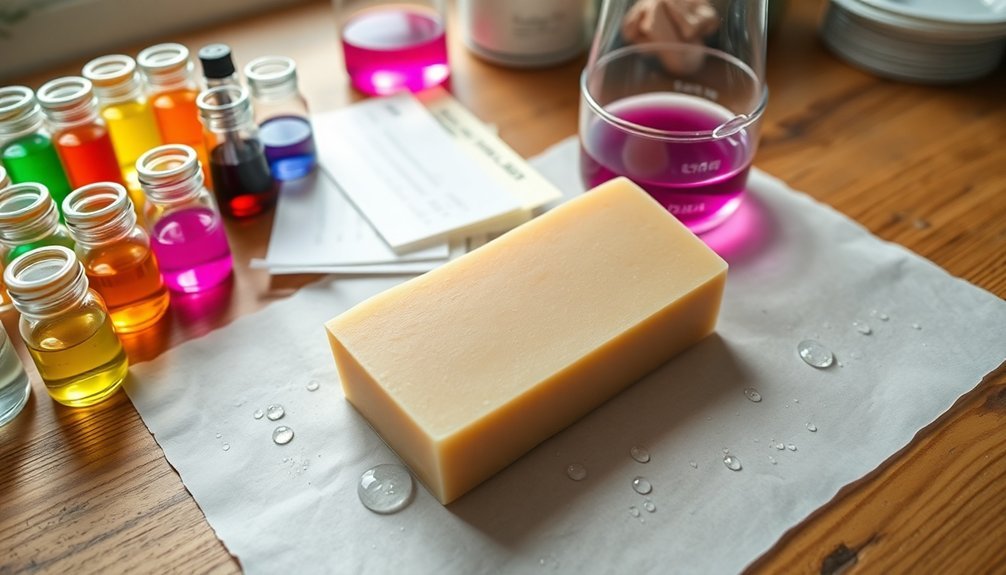
Three essential methods exist for testing your handmade soap's pH at home.
First, use pH testing strips with your soap lathered in distilled water at a 1% solution to get more accurate readings. This method works well for cold process soap makers on a budget.
Second, invest in a digital pH meter (around $15) for precise measurements. These devices provide exact numerical values, helping you confirm your soap falls within the safe range of pH 8-10.
Third, create a homemade universal indicator using red cabbage juice, which changes color based on soap acidity. This natural alternative provides visual feedback without special equipment.
Remember to monitor changes throughout the curing process.
Any DIY soap making kit should include pH testing tools to guarantee your creations are skin-safe.
Understanding Ph Basics in Soap Making
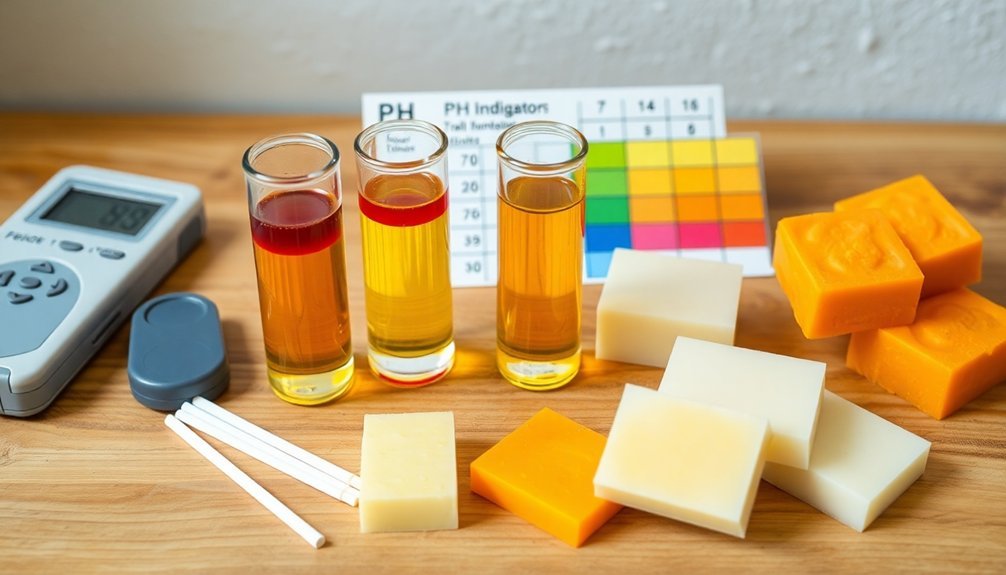
Before diving into testing methods, you'll need to grasp what pH actually means for your soap creations. pH measures hydrogen ion concentration on a scale from 0-14, with 7 being neutral, lower numbers indicating acidity, and higher numbers showing alkalinity.
Properly understanding pH in soapmaking helps guarantee your products are safe to use:
- Handmade soap naturally falls between 8-10 on the pH scale after saponification
- High readings might indicate excess alkali, which can cause chemical burns
- pH testing serves as a valuable quality control tool in your process
- Normal pH doesn't guarantee gentleness – other factors also affect skin compatibility
- Monitoring pH helps prevent unreacted lye in your final saponified products
Mastering pH basics allows you to troubleshoot issues and create consistently safe soap.
Natural Ph Indicators You Can Make at Home
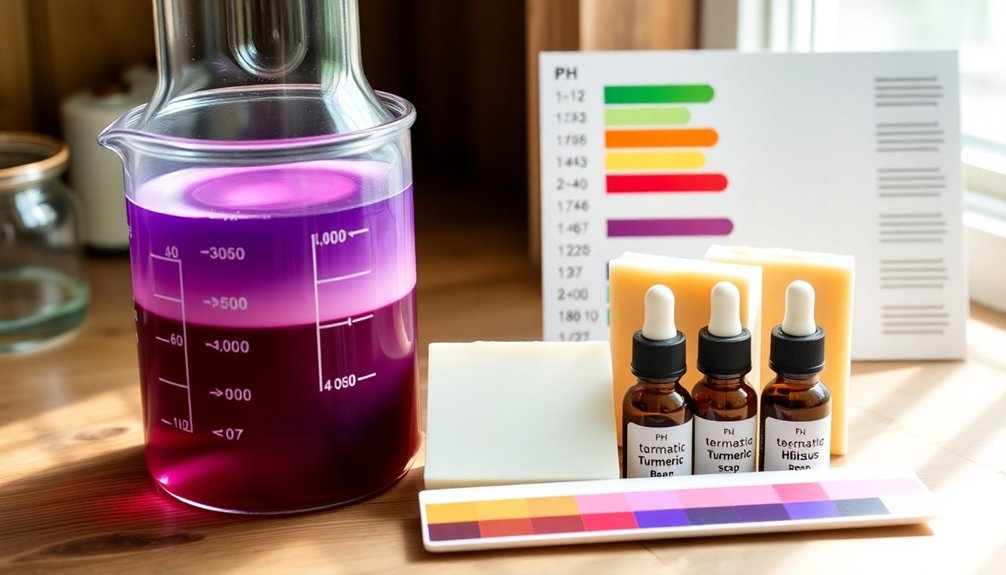
You can create a red cabbage indicator solution by boiling chopped cabbage and collecting the purple liquid that changes color when exposed to different pH levels.
For a convenient option, try making turmeric paper strips by soaking filter paper in a turmeric solution and allowing it to dry before using it to test your soap's pH.
If you're looking for another alternative, the hibiscus tea method offers a simple approach where you'll steep dried hibiscus flowers to produce a natural indicator that shifts from red to blue depending on your soap's acidity or alkalinity.
Red Cabbage Indicator Solution
Nature's chemistry provides soap makers with a brilliant alternative to store-bought pH testing solutions.
Red cabbage contains anthocyanins that transform it into a powerful pH indicator perfect for DIY soap making. You'll love how this non-toxic solution clearly reveals whether your soap has reached the proper pH.
To create your own red cabbage indicator:
- Chop a small head of red cabbage and boil in water for 30 minutes
- Strain the liquid to collect the purple solution
- Add a few drops to your diluted soap sample
- Watch for color changes: red in acidic conditions (pH < 7)
- Green to yellow indicates alkaline conditions (pH > 7)
This simple test helps guarantee your handmade soaps are safe for skin use while keeping your process completely natural and chemical-free.
Turmeric Paper Strips
Alongside the color-changing properties of red cabbage, turmeric offers another accessible option for soap makers seeking natural pH testing methods. You can create turmeric paper strips by soaking plain paper in a turmeric solution—simply mix turmeric powder with water or alcohol—and allowing it to dry completely.
When your handmade soap touches these yellow strips, they'll turn reddish if your soap is alkaline, functioning as an effective pH indicator. The color change occurs in the pH range of 7-9, making it ideal for testing typical handmade soaps.
While this DIY solution is convenient and cost-effective, remember that turmeric strips lack the precision of commercial pH meters. Results can be subjective, so use these strips for general guidance rather than exact measurements when evaluating your soap's alkalinity.
Hibiscus Tea Method
The vibrant hibiscus flower offers soapmakers another excellent natural pH testing option with its remarkable color-changing properties. This homemade pH indicator transforms from deep red to pink or purple when exposed to alkaline solutions, making it perfect for testing soap pH levels.
To create your eco-friendly hibiscus tea indicator:
- Steep dried hibiscus flowers in boiling water for 15-20 minutes
- Allow the solution to cool completely before testing
- Apply a drop to your diluted soap sample
- Watch for the color change – red indicates acidity, while pink/purple signals alkalinity
- Compare with a pH scale for more accurate readings
You'll appreciate this natural alternative to commercial pH strips, as it's both safe and effective for determining if your handmade soap has reached the proper alkalinity level for safe use.
Red Cabbage Solution: the Ultimate DIY Ph Test
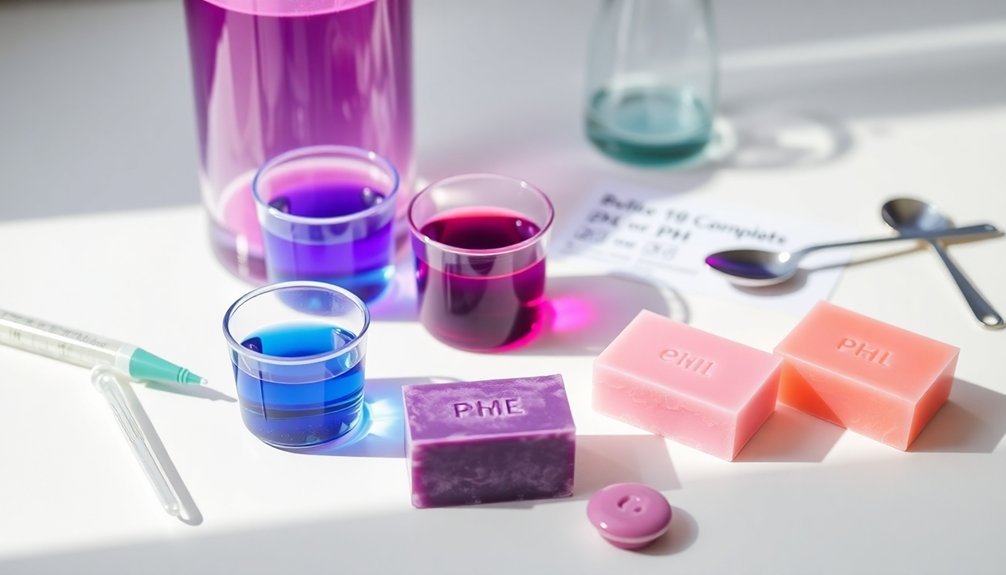
Ancient wisdom meets modern soapmaking with red cabbage's remarkable pH testing abilities. This vibrant vegetable contains anthocyanin, a natural pH indicator that changes color when exposed to different solutions.
You'll find creating this test solution surprisingly simple. Chop a few red cabbage leaves, boil them for 30 minutes, then strain the resulting purple liquid.
To test your soap, add a few drops of this solution to your soap sample and watch the color transformation happen before your eyes.
Red turns acidic (pH < 7), purple indicates neutral (pH = 7), while green or yellow reveals alkaline properties (pH > 7). Compare these colors against a pH scale chart for more precise readings.
This eco-friendly, non-toxic method offers soapmakers an affordable alternative to commercial pH strips while delivering reliable acidity and alkalinity measurements.
Turmeric-Based Ph Testing for Soap Crafters
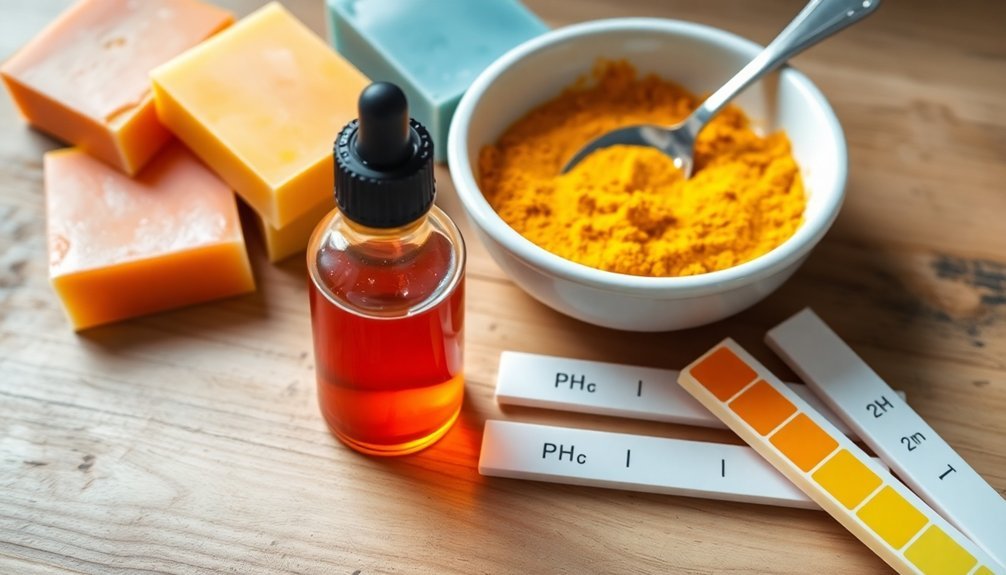
Turmeric offers you a natural, cost-effective alternative to commercial pH indicators when testing your handcrafted soaps.
You'll need to mix turmeric powder with water to create a paste that changes from yellow in acidic environments to reddish in alkaline solutions.
While this method provides a quick visual assessment of your soap's pH level, you should pair it with pH strips or meters for more precise measurements in your soap crafting process.
Natural Indicator Benefits
While many soap crafters rely on commercial pH testing strips, natural alternatives like turmeric offer compelling advantages for those seeking sustainable and non-toxic options.
Turmeric's active compound, curcumin, serves as an excellent pH indicator that changes from bright red in acidic solutions to yellow in alkaline environments.
- You'll avoid synthetic chemicals while still accurately measuring your handmade soaps' pH
- The visual representation provides clear feedback within the vital 7-12 pH range
- Creating your indicator is simple—just mix turmeric powder with water to form a paste
- You'll save money compared to purchasing commercial testing supplies
- It's completely non-toxic and safe for both sensitive skin and the environment
This natural testing method aligns perfectly with the artisanal philosophy that draws many crafters to soapmaking in the first place.
Turmeric Solution Preparation
Creating your own turmeric-based pH testing solution elevates your soapmaking process with a simple, natural approach. To prepare this vibrant indicator, dissolve 1 teaspoon of turmeric powder in 100 milliliters of distilled water and mix thoroughly.
The magic lies in curcumin, turmeric's active compound, which responds visibly to different pH levels. When you apply this solution to your soap, you'll notice it remains yellow in acidic or neutral environments (pH below 7) but transforms to reddish-brown in alkaline conditions (pH above 7).
This cost-effective method gives you immediate visual feedback about your soap's pH status. While it won't provide exact numerical values like commercial pH meters, it's an excellent qualitative tool for crafters who prefer working with natural materials in their soap-making journey.
Color Change Interpretation
When you apply turmeric solution to your soap samples, understanding the resulting color changes becomes your key to interpreting pH levels accurately. This natural indicator transforms in response to your soap's acidity or alkalinity, providing a qualitative assessment of your handmade creation.
- Turmeric turns bright red when it encounters acidic conditions (pH below 7)
- A yellow hue indicates alkaline conditions (pH above 7), typical for most handmade soaps
- Mix a small amount of diluted soap with your turmeric solution made from distilled water for best results
- Compare the resulting color against a pH scale for reference, though precision will be limited
- Remember that while not as precise as electronic meters, this method offers crafters a quick, visual confirmation of appropriate alkalinity levels
Creating Accurate Ph Test Papers From Scratch
If you've ever wanted complete control over your soap's pH testing, making your own test papers is surprisingly straightforward. Start with clean filter paper or chromatography paper as your base material.
Create a natural pH indicator by boiling red cabbage in water, then strain and cool the vibrant purple liquid. Thoroughly saturate your filter paper in this solution and allow it to dry completely before cutting into strips.
These homemade pH test strips will change color when exposed to different acid or alkaline substances.
Store your prepared strips in an airtight container away from light to prevent degradation. When testing, simply wet a strip with your soap solution and compare the resulting color change to a reference chart you've created using known pH values.
This method guarantees accurate pH readings for all your handmade soap creations.
Common Kitchen Items That Indicate Ph Levels
Many soap makers don't realize they already have effective pH testing tools in their kitchen cabinets. These everyday items can reveal whether your homemade soap has reached the proper alkaline balance without expensive equipment.
- Red cabbage juice serves as a natural pH indicator, turning red in acidic solutions and green/yellow in alkaline solutions like soap.
- Turmeric powder changes from yellow to reddish-brown when exposed to basic substances, making it ideal for testing high-pH soaps.
- Lemon juice provides a reliable acidity comparison point with its pH around 2.
- Vinegar can be used alongside baking soda to create before/after pH demonstrations.
- Club soda's mild acidity (pH 4-5) offers a middle-ground reference when testing.
These simple kitchen staples give you multiple options for confirming your soap's pH level accurately and affordably.
Interpreting Color Changes in Homemade Ph Tests
Now that you've identified household pH indicators, understanding what their color changes actually mean becomes the next step in your DIY soap testing journey.
When you dip pH strips into your soap solution, the resulting color change provides critical information about acidity or alkalinity levels.
Lower pH values (acidic) typically display red or yellow hues, while higher values (alkaline) shift toward green or blue. For accurate interpretation, always compare your results against a standardized pH scale chart.
Remember that the concentration of soap in your solution can influence color intensity.
For reliable results, conduct your tests in a controlled environment using fresh indicators. Expired or improperly stored pH strips may yield misleading readings.
Calibrating Your DIY Ph Testing Solutions
Even the most carefully prepared homemade pH indicators require proper calibration to deliver reliable results for your soap testing. Without proper calibration, your pH testing efforts might yield misleading information about your soap's alkalinity.
To guarantee accurate measurements when using DIY pH testing solutions:
- Purchase standard buffer solutions (pH 4.00, 7.00, and 10.00) to calibrate your testing equipment
- Follow your pH meter's manufacturer instructions precisely, as calibration procedures vary between devices
- Rinse the electrode with distilled water between readings to prevent cross-contamination
- Calibrate regularly before testing soap to account for accuracy drift
- Check the expiration date on pH strips, as outdated materials produce unreliable results
This calibration process might seem tedious, but it's essential for obtaining trustworthy pH readings that truly reflect your soap's quality.
Frequently Asked Questions
How to Test Ph Levels in Homemade Soap?
You'll need to create a 1% soap solution by mixing 1g soap with 99g boiled distilled water. Once dissolved, test with pH strips or a digital meter, aiming for readings between 8-10.
How Do You Make a Homemade Ph Tester?
To make a homemade pH tester, boil red cabbage for 30 minutes, strain the purple juice, and let it cool. It'll change colors when you add it to substances—pink for acids and greenish-yellow for bases.
How Do You Test Ph in Saponification?
You'll create a 1% soap solution by dissolving 1g of soap in 99g of boiled distilled water. Then use a digital pH meter or quality pH strips to measure, aiming for a pH between 8-10.
What Things at Home Can You Use to Test Ph?
You can test pH at home using red cabbage juice, baking soda solution, vinegar, turmeric powder mixed with water, or lemon juice. Each will show different reactions or color changes depending on acidity or alkalinity.
In Summary
You've now got all the tools to create your own pH testing solutions! By using natural indicators like red cabbage and turmeric, you'll save money while ensuring your handmade soaps are safe for skin. Remember to calibrate your homemade indicators regularly and keep notes on color changes. With these DIY methods, you're well-equipped to monitor pH levels and create perfectly balanced soaps every time.

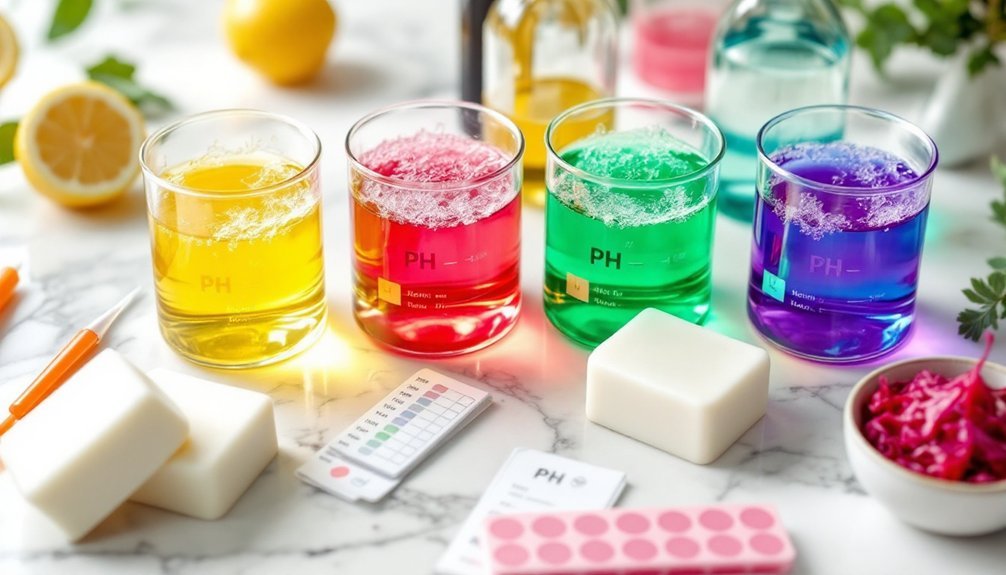



Leave a Reply